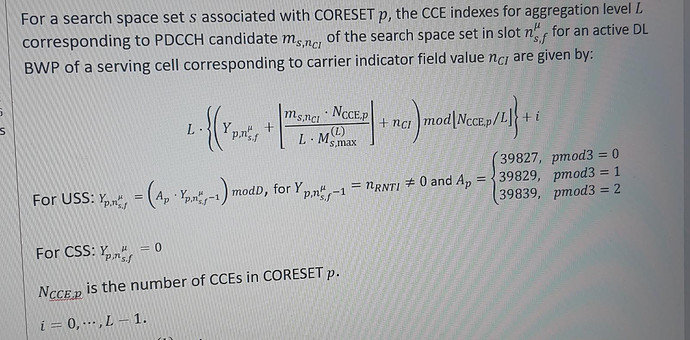Hello Experts.
Anyone has seen this equation?
It’s now the most complex equation in the 5G NR spec.
 my brain switches off as soon as it sees any such equation.
my brain switches off as soon as it sees any such equation.
Simple arithmetic is best I can help with.
Btw is USS user specific search space and CSS common search space?
Yes mate!
What Im trying to do is this:
Trying to solve a problem that I have different UEs with different RA -RNTs collide with same cce index according to this equation.
So I’m having collision and trying to fix that.
In LTE we have that scenario. In 5G by this equation we still have that scenario of collision, but 5G flexibility which we can solve those collisions problem.
Mean to reduce the scenarios of having much collisions.
Like maybe if we substitude ra-rnti to groups then can solve the problem?
This equation at the end give you implicitly index of cces for RA-RNTI allocation.
But there is possibilities multiple different RA-RNTIs having same index of cces (same indexes of cces for different RA-RNTis that this equation give us).
5G formula is a generalized version of LTE formula.
Better to start with the LTE and use numbers to get it and then you can easily understand the 5G one
In LTE (according to LTE equation) , there can be two different RA-RNTis (different UEs) get same cce index, right?
So eNB (scheduler) will schedule one of them and the other will may schedule in next round.
That’s collisions in LTE that cant be avoided. Yes?
No don’t think so. This is fundamental of contention-based open loop access method.
Yes, that’s what I’m trying to say, in LTE we can’t avoid collisions (avoid contention based open loop access).
So in LTE we have issue of opportunity collision for different rntis that cce equation mapped their dci to same index cce i (different UEs in same subframe).
In 5G NR I guess we can solve that because in 5G NR we have what called search spaces for each CORESET. It means that for CORESET we can have maximum 12 search space on the grid.
It means if I have multiple different UEs (different rntis) have same cce index (assume equation of cce mapping gave us same index i) so now we can use the search spaces to lower collisions.
But we need to do/suggest a wise choose for rntis at gNB to take advantage of independent search spaces for same CORESET (for multiple UEs that have same cce index) to map them in different search spaces.
It makes sense but I’m not very good in 5G RACH procedure.
From what you explain, 5G has lower probability for collision but it is still possible.
Really weird!
In 5g nr How same index can be used in coreset to avoid collision between multiple UEs? In LTE can’t be solved!
In other words: In 5G NR how same index of cce mapping can be used for same coreset for different multiple UEs to avoid collision between multiple UEs?
There can’t be 2 RA RNTIs in a particular DL subframe…so no question of collision.
There is no collision on RA-RNTI neither in LTE nor in NR.
It is normal to have multiple UEs decoding the same CCE with the same RA-RNTI in success cases
Collisions might happen on RAPID though
